Understanding the ins-and-outs of pre-bid programmatic advertising can be a challenge. With such a rapidly changing data landscape, and the coming end of the third-party cookie, it can be tough to know what to look for in a new solution.
This guide will walk you through some of the key considerations when choosing a new pre-bid programmatic solution, and offer tips and insights on how to improve your ad performance and ROI.
Table of Contents
Why speed is important in a pre-bid programmatic solution
Most advertisers focus on understanding the pre-bid data itself; the quality of categorization, or features, such as whether the data asset can support custom-keyword targeting and avoidance. These are important to understand, and there are differences among vendors, but advertisers should also fully understand the differences in how companies do what we do.
What is the process for a bid request or an impression being classified? Is it classified using the URL or the domain? What happens if a page is new and there is no data? How long does a new classification take to be available for targeting? All of these questions are really important and should be understood by anyone choosing a pre-bid targeting, contextual or brand safety solution.
This guide gives advertisers baseline knowledge of all pre-bid providers, and Peer39-specific information.
Pre-bid targeting, contextual, and brand safety: how it works
As a starting point, pre-bid contextual and brand safety providers are providing data to the buying platform. For every bid request that a DSP gets from an SSP or exchange, the DSP looks up the data available via a cache mechanism. In most situations, it’s an internal cache at the DSP populated with data from an external cache from the pre-bid provider. The data in the cache will be associated with the URL or the domain.
The process looks something like this:
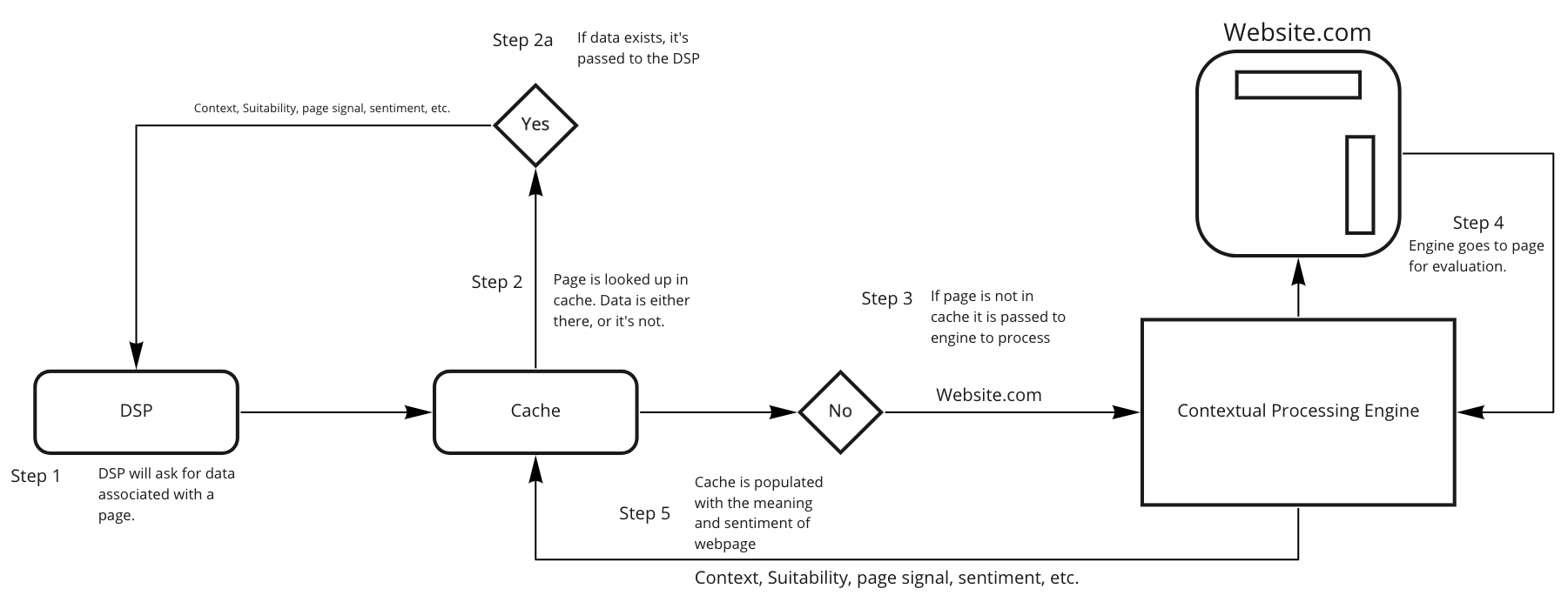
Pages vs Domains
When an ad opportunity is available for auction at a buying platform, like a DSP, it is associated with a page. That page (or URL) is part of a website (or a domain). Consider an ad opportunity on www.pre-bid-targeting.com/all_context_is_not_the_same : "all_context_is_not_the_same" is the page within the “pre-bid-targeting.com” site.
It’s important to know if data is provided at the page level, or at the domain level. Some providers will pre-index X number of pages across Y number of domains to populate their cache and store the response at the domain level.
Peer39 recognizes the context of each individual page and does not roll up to the domain level.
TTL (Time to Live)
Time To Live is a measure of how long a page or domain is kept in a cache and when it should expire. Peer39 has determined that 90% of all pages are new every 24 hours.
Because so much content is regularly created, Peer39 has a maximum time to live of 24 hours.
Populating the cache
When an ad opportunity is available for auction in the DSP, the DSP will look up the page in a cache for the contextual signals from the pre-bid provider. If the URL is a new page, one that was recently published and never seen before, there is likely no data available for that page.
Advertisers should understand what happens if there is no data for that page: pre-bid solutions will have multiple ways to treat these situations.
When a pre-bid provider recognizes that they don’t have any classification for a page, it starts a process to evaluate and extract the contextual data from the page and populate the cache. We call this a round trip.
The importance of time in pre-bid targeting
It's important to understand what the cache update process is for a pre-bid provider.. Time is literally money when it comes to this process. Faster classification means more scale and more scale means better performance.
In the example shown below, 41% of bid requests happened in the first hour.
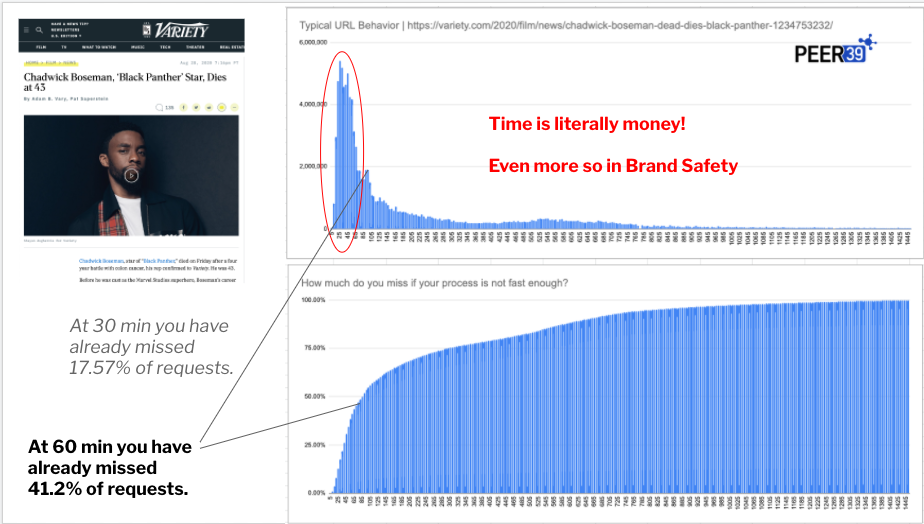
Advertisers trying to avoid a category or keyword list, run on this content until the pre-bid provider classifies updates their cache with the information that it is negative content.
Advertisers trying to target a category or keyword list would not appear until the pre-bid provider classifies and updates their cache with the resulting targets.
In each situation, speed is your friend, as it enables the pre-bid provider to produce the results quickly.
Choosing a pre-bid solution
Because not all pre-bid technology is the same, if your pre-bid provider is not processing pages in real-time, you are working with the wrong provider.
Some companies have post-buy brand safety/verification businesses and will use the ad delivery data to feed their cache.
This method is slow: it can take up to 24 hours for pages to be added or updated to the cache.
Additionally, this method does not see all of the URLs associated with standard ad delivery mechanics –most ads are delivered into iFrames and Safe Frames on publisher sites. This makes understanding the URL more challenging. Without visibility to the URL, how do advertisers know what’s on it?
Both of these result in reduced inventory scale available to advertisers.
Another method is to pre-scan or pre-crawl popular websites and build an index of webpages in advance.
With this method, there is often a mismatch between the time a page was crawled and the time the advertiser bids. The contextual data might be out of date, or inaccurate.
There can also be a mismatch between the crawled sites and pages and what is available to be bought through programmatic channels. If you only the top X number of sites are crawled, restricted to the same number of sites.
Each of these will result in lower scale of inventory in pre-bid.
Peer39 is the only company using First Look technology, processing at the URL level in real-time, This provides maximum scale for advertisers looking to target or avoid using keywords, context, or brand safety solutions
Why scale is important in a pre-bid programmatic solution
In this section, we’re going to show you how scale drives performance in a pre-bid programmatic targeting, contextual, or brand safety solution.
Traditional keyword targeting …
Look up the term “Exact Match” as it relates to advertising, and you will see many articles that equate Exact Match to performance.
Exact Match keyword targeting means that a word or phrase is exactly matched to the word or phrase in a document, search, or webpage. There are other techniques or ways to expand on word matching in these environments, many of which match against more instances and capture more scale. These include:
- broad match
- stemming, or
- probabilistic methodologies.
These methods are promoted as ways to find more of the same, so if you are a search advertiser, this helps capture things like misspellings or words that you might type that would result in the same search results.
Stemming is a technique that reduces the word to its root and then looks at other variants.
… versus pre-bid contextual keyword targeting
These methodologies might work fine in search advertising, but they are not ideal when using pre-bid targeting techniques like contextual signals for display and video advertising.
For instance, finding misspellings in web pages and articles does not add any scale, as there usually aren’t any, and stemming can often change the meaning of the word. Think about the differences between living and live, or organisms and organ.
So while this may increase scale, it will do so at the cost of the meaning. Don’t get me started on probabilistic. Do you want to reach the right audience, or do you probably want to reach the right audience?
Those that sell advertising based on words are very interested in presenting options that will help you scale because it means more advertising revenue for them. If you can sell more advertising by expanding words to broad match and misspellings, then anyone who gets a portion of ad spend will make more money.
Clearly, this is not good for the advertiser. Advertisers are looking for impressions that reach the right audience and perform. A tried-and-true method for driving better performance is an Exact Match methodology.
The issue for other pre-bid providers is scale. If you use Exact Match, you will reduce the scale compared with using other techniques.
Peer39’s capabilities and the sheer volume of pages we can process enables us to provide our customers with unmatched scale for their pre-bid targeting and avoidance strategies. Combining these capabilities with Exact Match means that you can reach the right audience, at scale, while maintaining a high standard of performance.
Why speed AND scale can reduce media cost in a pre-big programmatic solution
As mentioned, not all pre-bid targeting, contextual advertising, and brand safety providers are the same. Each provider’s technology and speed of processing URLs can create differences in scale. There is another problem in working with a pre-bid targeting provider that doesn’t scale, creating an issue very similar to the market dynamics seen in the competition for audience buying.
The effects of shrinking inventory in programmatic advertising
Everyone who buys media via programmatic right now can attest to the fact that the scale of impressions is dropping and the cost of the media is increasing. This is because the same advertisers are trying to reach a shrinking pool of users. As such, the competition is increasing, driving up the cost of reaching those users. The increase in cost is in the access to data, and also in the cost of media.
Now imagine that a large population of advertisers is also using a pre-bid technology provider that has proven issues with scale. Earlier in this article, we explained a few reasons why other companies and technologies would have issues with scale, so we won’t go into that here.
But let’s also say that all of these advertisers have similar lists of target keywords (or avoidance keywords), meaning that they are all trying to reach or avoid the same context or topic. You now have competition on the same–or similar–lists of words. Competition drives increases in media cost, and the winning advertiser now ends up spending a bit more on the contextual advertising as well.
The issue becomes even more acute when you are working with a pre-bid data solution that doesn’t have enough scale.
In that case, there is a greater number of advertisers competing for similar pre-bid targeting, on a small subset of total available inventory. It’s not uncommon to see CPMs exceed $15 for standard display when targeting contextual signals and going up against competitors. When the media costs more, you become less efficient at reaching your goals.
How working with a pre-bid targeting partner can help
So how do you drive more efficiency with your pre-bid targeting?
Easy, work with a pre-bid partner that can achieve maximum scale. Processing pages that the other providers aren’t means that there will be far less competition on those pages, which will reduce media CPMs.
How you can achieve 50% more efficiency with a pre-bid programmatic solution
We have demonstrated how speed creates scale in a pre-bid targeting solution, and how scale drives performance. We also discussed how both speed and scale can reduce media cost. This section brings them all together into a super efficient package.
There are a number of real and tangible reasons why speed, scale and performance drive these efficiencies.
Let’s look at each individually.
Speed
When an ad opportunity comes up for bid in a DSP, the DSP is going to look in its cache for the contextual signals from the pre-bid providers. A provider that has an answer without needing to wait to process the page or for the cache to be populated is able to understand that page the first time and know if it should be targeted or avoided, without needing to wait.
Peer39 processes more than 1.3 billion pages per day and responds in real time (even for brand new pages not seen before).
Classifications expire within 24 hours, and the process repeats itself.
Compare that to any other pre-bid data provider. Their process usually involves:
- No first look.
- Approximately 24-hour full classification. We have classified and thrown away our results in the time it takes others to classify a page.
- A fraction of the number of URLs processed daily.
As a reminder, in this example, 41% of bid requests happened in the first hour.
If you are trying to avoid a category or keyword list, your ads will run on content like this until your provider can classify it and understand that it is negative.
The inverse of that is that if you are trying to target to a category or keyword list, your ads will not appear until your pre-bid targeting provider can classify the content and update their cache.
Scale
Peer39 has approximately 30% to 50% more scale than any other pre-bid keyword, contextual, or brand safety solution.
Scale is a direct result of our speed and our volume. Peer39 processes more than 1.3 billion pages per day and responds in real time.
Compare that to other providers at 450 million URLs per day, and no real-time processing.
In short: that leads to better performance.
Look up the term exact match on the internet and you will see many articles that equate exact match to performance. The issue for other pre-bid targeting providers is scale. If you use exact match, you will reduce the scale compared with using other techniques like broad match, stemming, or probabilistic methodologies.
Cost
Peer39 data is 20% less expensive than the competition (calculated based on custom categories at $0.25/m), giving you significant data cost savings.
Because Peer39 also has more scale than any other pre-bid data provider, we process pages and volume not processed by any other provider. The result? Less competition on each impression because the pool of impressions is approximately 30% to 50% larger. This reduces your overall media cost
Our real-time capabilities and the sheer volume of pages we can process enables Peer39 to provide our customers with unmatched scale for their pre-bid targeting and avoidance strategies. This, combined with exact match, means that you can reach the right audience, at scale, with greater performance.
Couple that with 20% less expensive data costs, as well as lower media costs due to less competition, and your media dollars will drive even more efficiency.
It’s important to realize that you don’t need to change anything about your strategy, goals or budget. All you need to do is test Peer39 against your other pre-bid targeting or avoidance vendor, and experience the efficiency for yourself.
Why you should continue to use a post-buy verification solution (just not for pre-bid programmatic targeting)
We have demonstrated how speed creates scale, how scale drives performance, how both speed and scale can reduce media cost, and how you can generate 50% more efficiency in your campaigns by using your existing strategy and simply changing your pre-bid targeting, contextual, or brand safety solution.
This section focuses on why you should continue to use a post-buy verification provider, and why you shouldn’t use that provider as your pre-bid solution.
Verification providers deliver a tremendous amount of value to advertisers looking to ensure that they only pay for real users that have seen their ads in a brand-safe and suitable environment. They exist to verify that what the advertiser bought is the same as what the advertiser received.
Somewhere along the way these companies moved from verification to selling data. This creates a conflict of interest, because they now grade their own homework. At the same time, having similar technology that understands a webpage does not mean that they are proficient as a pre-bid data provider.
As a pre-bid provider, Peer39 has made the conscious decision not to offer verification solutions even though we offer pre-bid brand safety. We have made this decision for a number of reasons.
Primary among them is that it’s a very different business with different technology, costs, and support structures. It might seem logical that a company that is good at one would be good at the other, but both capabilities require a lot of technical expertise and very different infrastructure.
The verification providers do offer pre bid-targeting through the various DSPs however, as we have described in this series, not all technology has the same capabilities.
Beware of contextual technology addons
Context is a significant ingredient in understanding brand safety and suitability. All of the verification providers need some technology to understand context to support their brand safety reporting. They have either built this, rented it, or bought it.
In recent times we have seen two of the most popular verification companies buy other companies for their contextual capabilities, however, neither of these acquired companies were pre-bid data providers. This is important, because there is a lot of technology required to support a pre-bid environment with contextual signals. It’s not just about the technology to understand the meaning and sentiment of webpages — it’s about the ability to do that at scale. Processing the hundreds of billions of bid requests and doing so quickly gives advertisers the most scale available for their campaigns.
As a contextual solution, supporting publishers is fairly trivial as it relates to scale. The average publisher has tens of millions of page views on a monthly basis. Large publishers may have a billion page views per month, but those are people coming to one site, or a group of owned and operated sites. The actual number of URLs produced on a monthly basis is a fraction of the total pageviews.
Processing the URLs of some publisher accounts is not the same as processing 1.3 billion pages on a daily basis through the real time channels.
The speed factor
The process of understanding a web page after the ad has been delivered is very different than understanding the page before an advertiser bids or buys the impression. With verification, the verification provider has approximately 24 hours to review URLs and produce their reports for advertisers to review by the following day. There is no need to be faster for this use case.
When verification providers decided to sell data in pre-bid, they took on the task of populating a cache for the DSP to call. If the tech provider is leveraging its existing technology, then it is likely populating a cache based on the impressions they have already processed, and that can be 24 hours later than the impression currently up for auction.
In some platforms, it is even documented that when you build something new like a KW category, it could take 24 hours for the insights to be available for targeting.
The scale factor
The scale of impressions in verification that need evaluation are also significantly smaller than what you would see in a pre-bid targeting environment.
Consider this: a DSP is evaluating hundreds of billions of impressions, or bid requests, each day so that advertisers can bid and buy the impressions they want. Advertisers have daily budgets that help them to plan out how many users they will reach with each creative message.
The largest advertisers are only buying a fraction of what is available to them. But the DSP is evaluating every single impression so that it can give advertisers the best opportunity to find their target audience and deliver their ads.
Verification providers, by nature of where they sit in the process, are evaluating what has already been bought by their advertiser clients, which is far less volume than the DSP is seeing.
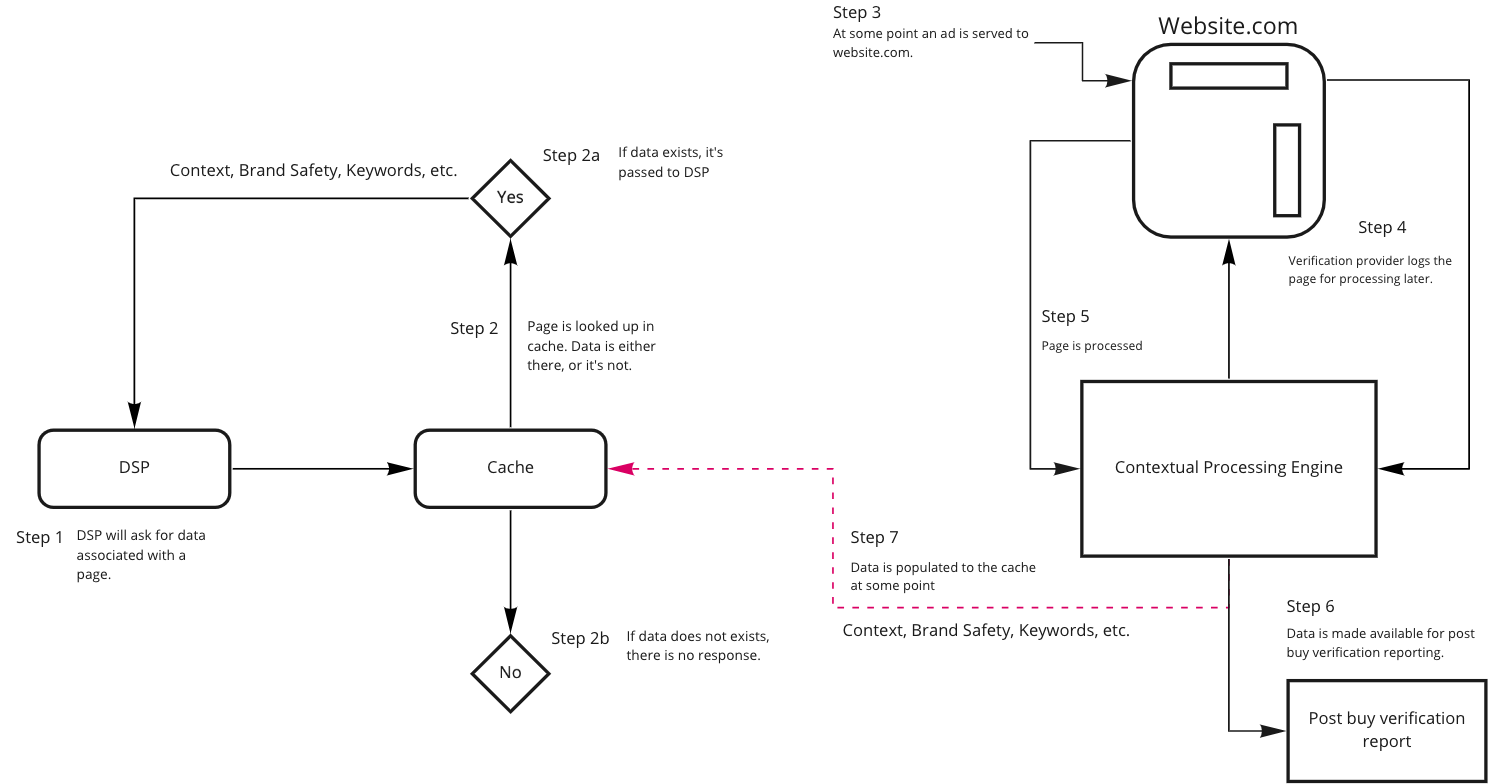
Avoid layering providers
We run into a lot of advertisers that will choose one provider for context or keywords, but will still use their verification provider for pre-bid brand safety. We just explained how speed and scale will help drive performance and efficiency. There is one other major problem. When you choose a provider that lacks maximum scale, you are limited to the scale that they do have, even if you are also targeting-based on a data provider that has scale.
Consider this: If you are retargeting based on shopping carts on an e-commerce site, the universe of available impressions is restricted to those users who were in the shopping cart at one point. The same is true of Context and Safety, and scale limits what a data provider can say about an impression.
You can target a custom keyword list for travel with one provider and use another provider to keep you off of pages with negative associations, such as “accidents.” But when you do this, both providers play a role in restricting the available inventory. If one provider processes fewer URLs then the other, or takes more time to produce a result, then the available inventory — and the number of ads you ultimately serve — is restricted by the smaller provider.
As a chain is only as strong as its weakest link, your scale will only be as big as your smallest provider in pre-bid programmatic advertising.
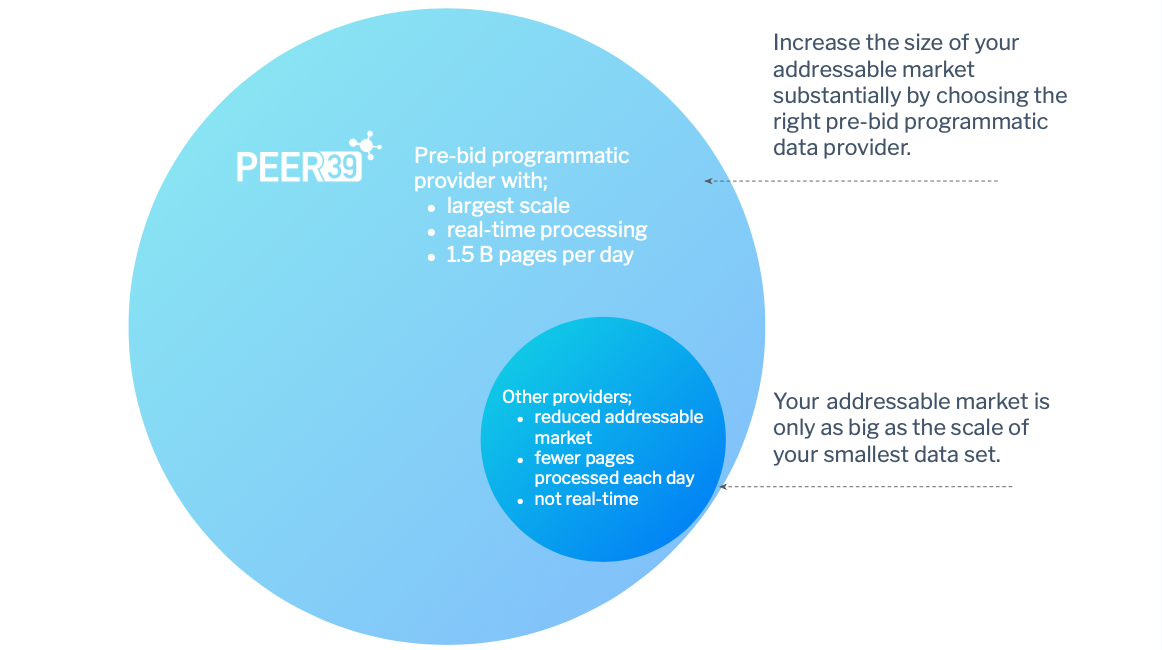
Choose an expert in pre-bid targeting
With this article, we hope we have provided a real understanding of what it takes to provide a pre-bid targeting, contextual, and brand safety solution, and how these solutions are very different from one partner to another
Peer39 was the first to integrate our technology into real-time bidding environments in 2010, and since then we have scaled our technology and capabilities at the same rate that RTB grew. We’ve gone from 1 billion bid requests in 2010 to more than 750 billion requests per day across all of our integrated partners, and we now process over 1.3 billion unique pages per day.
Technology partners can’t just go and buy a publisher solution that deals with tens of millions of publisher pages and plug it into pre-bid. It won’t scale, and picking the wrong provider means that your advertising won’t scale either.
Peer39 is pre-bid targeting only. We are the best at it.
By choosing Peer39, you are not replacing your brand safety and verification provider, you are making that relationship better by ensuring you are able to buy more media at scale.
You can, and should, continue to use your post-buy verification providers, but it is unwise to think that because they are great at verification, that they would be great at pre-bid. d
More Posts
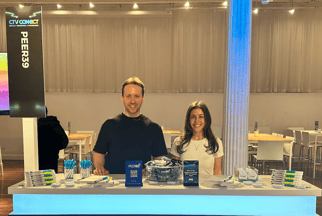
Takeaways from CTV Connect 2025: CTV Expectations & Challenges
CTV Connect brought together over 500 decision-makers from across the entire Connected TV ecosystem for a two-day conference in New York City. With so much growth and rapid changes, there were lively conversations, panels, and roundtables around measurement, audience engagement, AI, budgeting strategies, and transparency.

